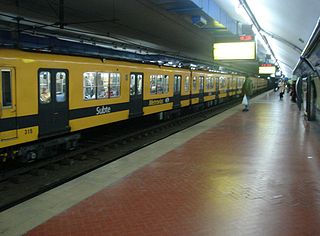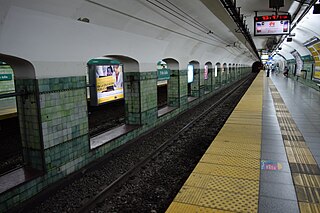
The Buenos Aires Underground, locally known as Subte, is a rapid transit system that serves the area of the city of Buenos Aires, Argentina. The first section of this network opened in 1913, making it the 13th earliest subway network in the world and the first underground railway in Latin America, the Southern Hemisphere, and the Spanish-speaking world, with the Madrid Metro opening nearly six years later, in 1919. As of 2023, Buenos Aires is the only Argentine city with a metro system.

Palermo is a barrio or neighborhood of Buenos Aires, Argentina. It is located in the north of the city, near the Rio de la Plata.

Line D of the Buenos Aires Underground runs from Catedral to Congreso de Tucumán. The line opened on 3 June 1937 and has been expanded to the north several times. The line is currently 11 km long and has 16 stations, while running approximately parallel to the city's coastline.

Line I is a planned addition to the Buenos Aires Underground.

Florida is a neighborhood in Vicente López Partido, Buenos Aires Province, Argentina. The community is a suburb in the Buenos Aires metropolitan area. In 2020 the population was estimated at 48,158, making it the second most populated neighborhood in Vicente López. It is located 15 kilometers north of downtown Buenos Aires.

Avenida Scalabrini Ortiz is an avenue that runs through Villa Crespo and Palermo neighborhoods of Buenos Aires, Argentina, and goes from southwest to northeast, parallel Avenida Juan B. Justo. It starts at Avenida Warnes, and ends at Avenida Figueroa Alcorta.

The Premetro is a 7.4-kilometer long (4.6 mi) light rail line that runs along the outskirts of Buenos Aires, connecting with the Buenos Aires Underground line E, at Plaza de los Virreyes station and then to General Savio, with a short branch to Centro Cívico. It opened in 1987 and is operated by Metrovías. Originally, the Premetro was to include many more lines, but shortly after the privatisation of the railways the projects were postponed and never materialised and only "Premetro E2" was built.

Plaza Italia station is part of the line D of the Buenos Aires Underground. It is located at the intersection of Avenida Santa Fe and the roundabout surrounding Plaza Italia in Palermo. The station was opened on 23 February 1940 as part of the extension of Line D from Tribunales to Palermo.

Dorrego is a station on Line B of the Buenos Aires Underground. The station was opened on 17 October 1930 as part of the inaugural section of the line between Federico Lacroze and Callao.

Carlos Pellegrini is a station on Line B of the Buenos Aires Underground. From here, passengers may transfer to the Diagonal Norte Station on Line C and the 9 de Julio Station on Line D and Metrobus 9 de Julio. The station was opened on 22 July 1931 as the eastern terminus of the extension of the line from Callao. In December 1931, the line was extended further east to Leandro N. Alem.

Diagonal Norte is a station on Line C of the Buenos Aires Underground. From here, passengers may transfer to Carlos Pellegrini Station on Line B or 9 de Julio Station on Line D and Metrobus 9 de Julio. It is located near the Obelisco de Buenos Aires.

Independencia is a station on Line C of the Buenos Aires Underground. From here, passengers may transfer to the Independencia Station on Line E and Metrobus 9 de Julio. The station was opened on 9 November 1934 as part of the inaugural section of the line, from Constitución to Diagonal Norte.

Congreso de Tucumán is a station on Line D of the Buenos Aires Underground and is the current terminus. The station was opened on 27 April 2000 as the western terminus of the extension of the line from Juramento. It is located at the intersection of Cabildo and Congreso avenues. As of June 2015, the station connects to the Metrobus Cabildo bus rapid transit line that was opened that year. New underground passageways and station entrances were made for the station to provide easy transfer to the Metrobus line.

Scalabrini Ortiz Station is a station on Line D of the Buenos Aires Underground. The station was opened on 23 February 1940 as part of the extension of Line D from Tribunales to Palermo.

9 de Julio is a station on Line D of the Buenos Aires Underground. From here, passengers may transfer to Carlos Pellegrini station on Line B and Diagonal Norte station on Line C and Metrobus 9 de Julio.

Independencia is a station on Line E of the Buenos Aires Underground. From here, passengers may transfer to the Independencia Station on Line C and Metrobus 9 de Julio. The station was opened on 24 April 1966 as part of the extension of the line from San José to Bolívar.

Inclán - Mezquita Al Ahmad is a station on Line H of the Buenos Aires Underground. Here passengers may transfer to Metrobus Sur. The station was opened on 18 October 2007, as part of the inaugural section of the line, between Once - 30 de Diciembre and Caseros.

The Buenos Aires Metrobús is a 50.5 km (31.4 mi) network of dedicated separated lanes and stations for buses that serve the city of Buenos Aires, Argentina. Designed as a Bus Rapid Transit system, it mixes a few bi-articulated buses with conventional buses. The headway is the same as before the implementation of the system, and the buses on the system use the same brand as the main network, that is, maintaining their previous branding as common bus lines with their own numbers. The service operates 24 hours a day and 365 days a year, with 2-4 minute frequencies during the day and 10–15 minutes at night.

Avenida Juan B. Justo is an avenue that runs through Palermo and Recoleta neighborhoods of Buenos Aires, Argentina, and goes from southwest to northeast, parallel Pueyrredón avenue. It starts at Santa Fe avenue, and ends at Avenida General Paz.

The Regional Express Network was a planned commuter network system in Buenos Aires, which consisted in an underground connection among the 3 mainline railway stations of the city: Retiro, Constitucion and Once, in the north, south and west respectively.





















